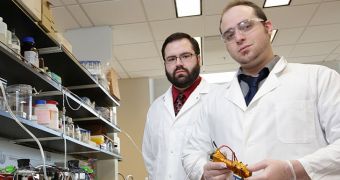The 3D printer market is an odd beast, having taken both the path of generalization and specialization almost as soon as the concept finally gained some fame a few years ago. What we have here today is an example of specialized equipment.
A pair of student researchers at the University of Alabama have created a 3D printing extruder that can be used in bioprinting. Their names are Tanner Carden and Devon Bane.
They are calling their invention the CarmAl extruder, which is really just an abbreviation, of sorts, for Carbohydrate Anhydrous Rapid Manufacturing Aluminum extruder.
Here, aluminum is the material that the extruder was made of, not the material that the extruder, or rather the 3D printer that ends up using it, makes items out of.
Well, technically it was Tanner's father, Rodney Carden, who made the extruder, although the two students came up with the idea.
He just took a $12 / €8.68 chunk of aluminum and made the thing at the General Dynamics plant where he is employed.
Tanner Carden and Devon Bane have since used the extruder to build a sugar grid that imitates the workings of blood vessels.
So how does the extruder do it? It has a modular tip that operates at a higher temperature than standard extruders, due to a specialized heating process.
The heating process allows the device to very precisely control the viscosity of a sugar solution, enabling the accurate vascular structures.
A software is used to control a solenoid valve that regulates the timing of nitrogen pushing against the sugar solution.
Bane and Carden had been stumped for a while, before Bane got a sudden idea and made a drawing of it, a very complex thing that Carden's father understood and used to make the extruder in just a day. The overall design is like a syringe apparently.
Keep in mind that the process is actually a sort of reverse 3D printing, where the structures are made first and then embedded in a cellular matrix. The cells are suspended in an "agarose" solution where they produce the vascular structure, after which a solvent is used to wash the sugar. The cell mass left accurately resembles living tissue and prevents necrosis as well.
The two students expect their invention to lower the costs of printing cellular structures used in testing drugs. Eventually, they hope to learn enough to allow for stem cells and then true 3D bioprinting.

 14 DAY TRIAL //
14 DAY TRIAL //